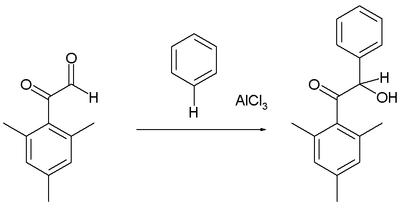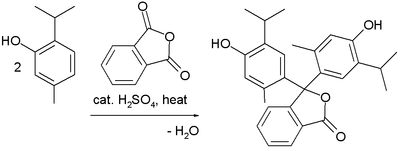This reaction has one big disadvantage, namely that the product is more nucleophilic than the reactant due to the electron donating alkyl-chain. Therefore, another hydrogen is substituted with an alkyl-chain, which leads to overalkylation of the molecule. Also, if the chloride is not on a tertiary carbon, carbocation rearrangement reaction will occur. This reactivity is due to the relative stability of the tertiary carbocation over the secondary and primary carbocations.[7]
Steric hindrance can be exploited to limit the number of alkylations, as in the t-butylation of 1,4-dimethoxybenzene.[citation needed]

Alkylations are not limited to alkyl halides: Friedel–Crafts reactions are possible with any carbocationic intermediate such as those derived from alkenes and a protic acid, Lewis acid, enones, and epoxides. An example is the synthesis of neophyl chloride from benzene and methallyl chloride:[8]
- H2C=C(CH3)CH2Cl + C6H6 → C6H5C(CH3)2CH2Cl
In one study the electrophile is a bromonium ion derived from an alkene and NBS:[9]

In this reaction samarium(III) triflate is believed to activate the NBS halogen donor in halonium ion formation.
[edit] Friedel–Crafts dealkylation
Friedel–Crafts alkylation is a reversible reaction. In a reversed Friedel–Crafts reaction or Friedel–Crafts dealkylation, alkyl groups can be removed in the presence of protons and a Lewis acid.[citation needed]
For example, in a multiple addition of ethyl bromide to benzene, ortho and para substitution is expected after the first monosubstitution step because an alkyl group is an activating group. However, the actual reaction product is 1,3,5-triethylbenzene with all alkyl groups as a meta substituent.[10] Thermodynamic reaction control makes sure that thermodynamically favored meta substitution with steric hindrance minimized takes prevalence over less favorable ortho and para substitution by chemical equilibration. The ultimate reaction product is thus the result of a series of alkylations and dealkylations.

[edit] Friedel–Crafts acylation
Friedel–Crafts acylation is the acylation of aromatic rings with an acyl chloride using a strong Lewis acid catalyst. Friedel–Crafts acylation is also possible with acid anhydrides. Reaction conditions are similar to the Friedel–Crafts alkylation mentioned above. This reaction has several advantages over the alkylation reaction. Due to the electron-withdrawing effect of the carbonyl group, the ketone product is always less reactive than the original molecule, so multiple acylations do not occur. Also, there are no carbocation rearrangements, as the carbonium ion is stabilized by a resonance structure in which the positive charge is on the oxygen.[citation needed]

The viability of the Friedel–Crafts acylation depends on the stability of the acyl chloride reagent. Formyl chloride, for example, is too unstable to be isolated. Thus, synthesis of benzaldehyde via the Friedel–Crafts pathway requires that formyl chloride be synthesized in situ. This is accomplished via the Gattermann-Koch reaction, accomplished by treating benzene with carbon monoxide and hydrogen chloride under high pressure, catalyzed by a mixture of aluminium chloride and cuprous chloride.[citation needed]
[edit] Reaction mechanism
In a simple mechanistic view, the first step consists of dissociation of a chloride ion to form an acyl cation ("acylium ion")[citation needed]:

In some cases, the Lewis acid binds to the oxygen of the acyl chloride to form an adduct.[11] Regardless, the resulting acylium ion or a related adduct is subject to nucleophilic attack by the arene:

Finally, chloride anion (or AlCl4-) deprotonates the ring (an "arenium ion") to form HCl, and the AlCl3 catalyst is regenerated:

If desired, the resulting ketone can be subsequently reduced to the corresponding alkane substituent by either Wolff–Kishner reduction or Clemmensen reduction. The net result is the same as the Friedel–Crafts alkylation.[citation needed]
[edit] Friedel–Crafts hydroxyalkylation
Arenes react with certain aldehydes and ketones to form the hydroxyalkylated product for example in the reaction of the mesityl derivative of glyoxal with benzene[12] to form a benzoin with an alcohol rather than a carbonyl group:


Friedel–Crafts reactions have been used in the synthesis of several triarylmethane and xanthenedyes.[17] Examples are the synthesis of thymolphthalein (a pH indicator) from two equivalents of thymol and phthalic anhydride:

A reaction of phthalic anhydride with resorcinol in the presence of zinc chloride gives the fluorophore Fluorescein. Replacing resorcinol by N,N-diethylaminophenol in this reaction gives rhodamine B:

[edit] Haworth reactions
The Haworth reaction is a classic method for the synthesis of tetralone.[18][19] In it benzene is reacted with succinic anhydride, the intermediate product is reduced and a second FC acylation takes place with addition of acid (see also: [1]).

In a related reaction, phenanthrene is synthesized from naphthalene and succinic anhydride in a series of steps.

[edit] Friedel–Crafts test for aromatic hydrocarbons
Reaction of chloroform with aromatic compounds using an aluminium chloride catalyst gives triarylmethanes, which are often brightly colored, as is the case in triarylmethane dyes. This is a bench test for aromatic compounds.
